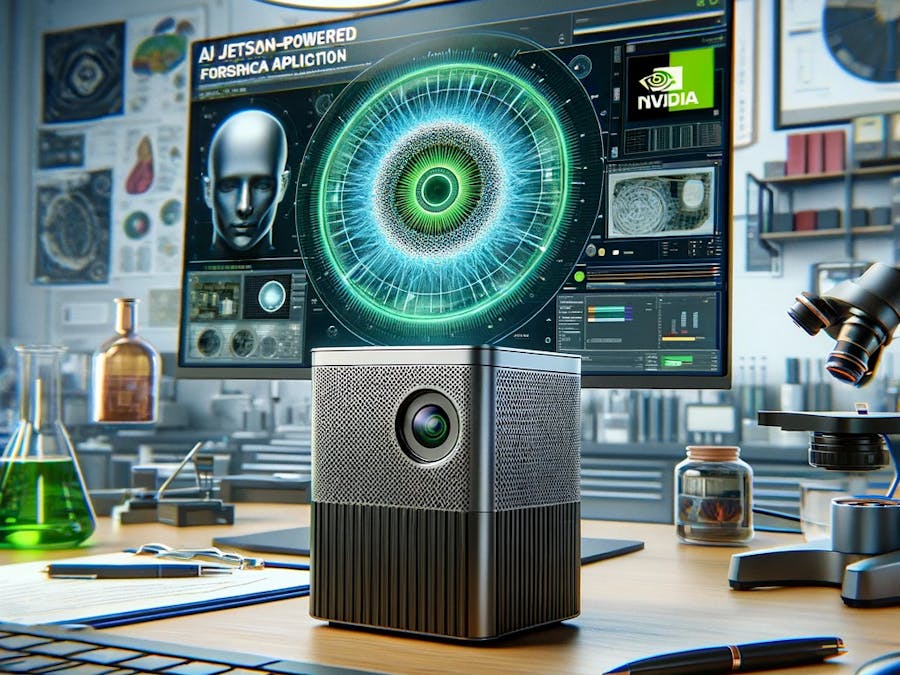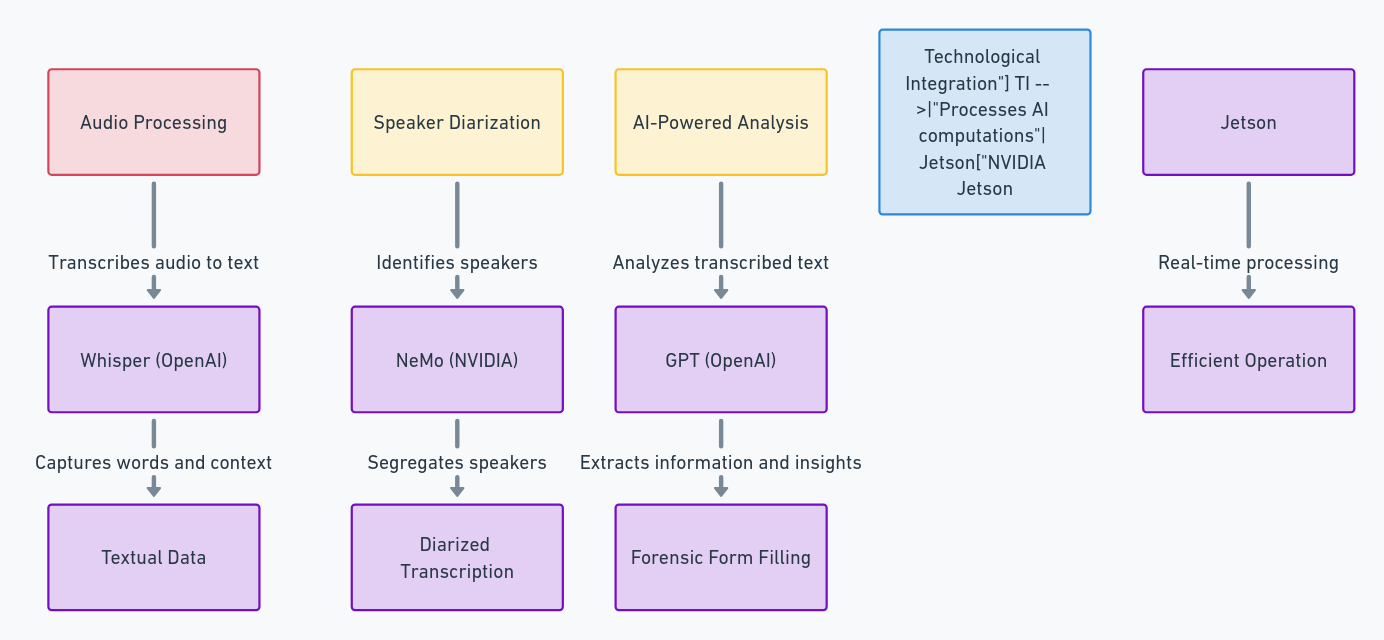NecroTalk: AI-Powered Forensic Assistant on NVIDIA Jetson
NecroTalk: Revolutionizing Forensic Documentation with AI
In the meticulous world of forensic science, the documentation process during necropsies is as crucial as it is labor-intensive. Recognizing the need for innovation in this domain, we introduce "NecroTalk" – an AI-driven solution designed to radically transform how forensic documentation is handled.
At its core, NecroTalk leverages the cutting-edge capabilities of artificial intelligence to automate the transcription and analysis of conversations during necropsies. By integrating OpenAI's Whisper for precise audio transcription and the powerful language processing abilities of the GPT model, NecroTalk efficiently converts the complex dialogue between forensic doctors into accurate, organized documentation. This automation significantly reduces the manual workload on forensic professionals, allowing them to focus more on the critical aspects of their work.
Our solution harnesses the robust processing power of the NVIDIA Jetson platform, exemplifying its potential in handling AI computations effectively at the edge. The use of NVIDIA Jetson not only ensures seamless processing and analysis of data but also underscores our commitment to integrating state-of-the-art technology in practical, impactful ways.
NecroTalk is more than just a tool; it's a pioneering step towards enhancing the accuracy and efficiency of forensic reporting. By reducing the time and effort required for documentation, it aims to streamline the entire necropsy process, ultimately contributing to more efficient forensic investigations and judicial processes.
In essence, NecroTalk embodies our vision to bridge the gap between advanced AI technology and vital forensic work, setting a new standard for innovation in the field of forensic science.
Inspiration
The genesis of "NecroTalk" was born out of a deep empathy and a keen observation of the challenges faced in the realm of forensic science. Our journey began with witnessing the struggles of forensic doctors and the emotional toll on families awaiting closure. In many instances, due to the limited availability of forensic experts, families endure prolonged waits to bid farewell to their loved ones. This waiting period, often fraught with uncertainty and grief, highlighted a critical need in the forensic process.
Equally compelling was our observation of the forensic doctors themselves, who frequently contend with overwhelming workloads. The meticulous nature of necropsies, coupled with extensive paperwork, often leads to prolonged hours of non-stop work. This exhaustive routine not only raises concerns about burnout among these dedicated professionals but also poses risks of errors in documentation, potentially impacting the quality of forensic investigations.
Our inspiration was further fueled by an unconventional source – the popular CSI TV show. While engaging with the show's depiction of forensic necropsies, we realized the potential of AI in transforming this critical yet overburdened field. The idea was not to mimic fiction but to harness the power of artificial intelligence in a way that could bring tangible improvements to real-world forensic processes.
Thus, NecroTalk was conceived with a dual purpose: to provide relief to forensic doctors from the daunting task of manual documentation and to expedite the process for grieving families awaiting closure. By automating the documentation process, our aim is to mitigate the risk of burnout among professionals and enhance the overall efficiency and accuracy of forensic reporting.
Our MVP, tested using simulated necropsy environments inspired by real-world scenarios and CSI episodes, validated our belief in the feasibility and impact of this solution. It demonstrated how AI, when thoughtfully applied, can be a powerful ally in areas where human expertise is invaluable yet strained.
NecroTalk is more than just a technological innovation; it's a testament to our commitment to improving crucial aspects of forensic science, offering a beacon of hope and efficiency in the face of challenging circumstances.
Problem StatementThe ChallengeIn the intricate field of forensic science, the process of necropsy reporting stands as a testament to both the dedication and the challenges faced by forensic professionals. Traditionally, this crucial task is characterized by its time-consuming nature, susceptibility to human error, and the significant manual effort required. Each necropsy demands hours of meticulous examination, followed by an equally exhaustive documentation process. This traditional method, heavily reliant on manual transcription and analysis, not only stretches the already limited time of forensic doctors but also increases the risk of inaccuracies in reports, which are critical in legal and investigative contexts.
Furthermore, the manual approach exacerbates the emotional strain on families awaiting closure. The prolonged time frame needed for traditional documentation directly impacts the speed at which reports are delivered, thus extending the grieving period of those affected. This situation is compounded by the finite number of skilled forensic experts available, creating bottlenecks and delays that ripple through the judicial process.
Need for InnovationThis landscape of forensic documentation is ripe for innovation, particularly through the integration of AI-based solutions. Automating the documentation process addresses multiple facets of the existing challenges:
Time Savings: By leveraging AI for transcription and analysis, NecroTalk significantly reduces the time required to complete necropsy reports. This efficiency not only benefits the forensic doctors but also the families awaiting crucial information.
Accuracy Enhancement: AI models like OpenAI's Whisper and GPT offer a level of precision in transcription and form filling that minimizes human errors. In a field where every detail counts, enhancing accuracy is not just a benefit – it's a necessity.
Focus on Critical Tasks: With the burden of documentation reduced, forensic professionals can redirect their focus and expertise to the more critical aspects of their work. This shift not only improves the quality of necropsies but also helps mitigate professional burnout by alleviating repetitive and strenuous manual tasks
Scalability and Accessibility: An AI-driven approach to forensic documentation democratizes the process, making it more scalable and accessible. This is particularly crucial in areas with a dearth of forensic experts.
- the need for an AI-driven solution like NecroTalk is clear and pressing. By blending the precision of AI with the expertise of forensic professionals, we can revolutionize the field of forensic science, making it more efficient, accurate, and humane. This is not just an advancement in technology; it's a step towards a more responsive and empathetic forensic process.
The cornerstone of NecroTalk's functionality begins with advanced audio processing done locally in the NVIDIA ORIN EDGE COMPUTER KIT. Utilizing OpenAI's Whisper, a state-of-the-art deep learning model, we transcribe the audio recordings of necropsies into precise textual data. Whisper adeptly handles this task by analyzing the audio feed from the necropsy, effectively capturing every word spoken by the forensic experts. This process not only ensures a faithful conversion of speech to text but also maintains the nuances and context of the conversation, which are vital in forensic analysis.
Speaker DiarizationTo further refine the transcription, NecroTalk employs the NeMo toolkit from NVIDIA for speaker diarization. This process involves identifying and segregating different speakers within the audio. By distinguishing between the forensic doctors' voices, NeMo clarifies who said what, adding an essential layer of detail to the transcription. This clarity is crucial in forensic documentation, as it ensures that each statement is accurately attributed to the correct individual, preserving the integrity of the conversational dynamics.
AI-Powered AnalysisOnce the transcription and speaker diarization are complete, the next phase involves the AI-powered analysis using the GPT model from OpenAI. This advanced language model analyzes the transcribed text, extracting key information and insights relevant to the necropsy. It then intelligently fills out the forensic forms based on this analysis. This automation not only streamlines the documentation process but also enhances its accuracy, ensuring that all vital details are captured and reported correctly.
Technological IntegrationAt the heart of NecroTalk's operation is the NVIDIA Jetson platform, which plays a pivotal role in processing the complex AI computations involved in the project. The Jetson platform's robust processing capabilities allow for efficient handling of real-time audio transcription, speaker diarization, and AI-driven analysis at the edge. This integration of NVIDIA Jetson not only underscores our commitment to leveraging cutting-edge technology but also ensures that NecroTalk operates with the speed and efficiency required in forensic contexts.
DemonstrationTo see NecroTalk in action and gain a deeper understanding of its implementation, you can explore our detailed demonstration on Google Colab: NecroTalk Demonstration on Colab.




.png?auto=compress%2Cformat&w=48&h=48&fit=fill&bg=ffffff)




Comments